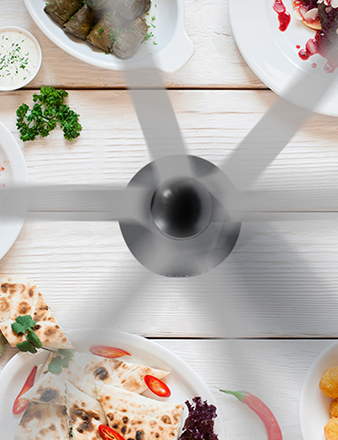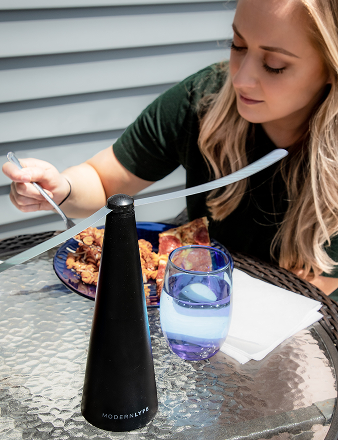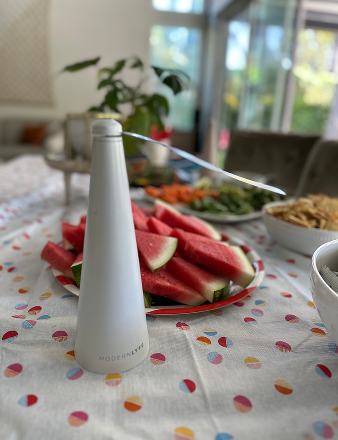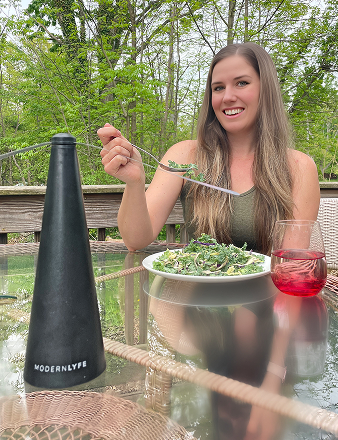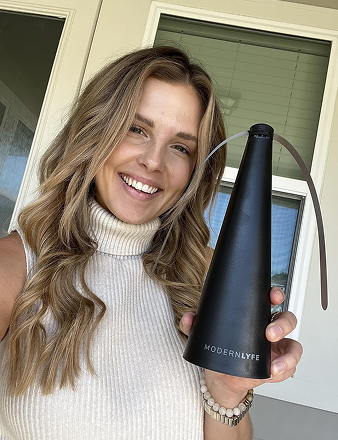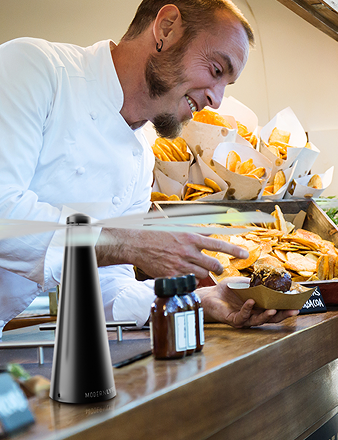Preventing food contamination isn't a single action—it's a system. It’s about combining smart habits: cleaning surfaces, separating raw and cooked foods, hitting the right temperatures, and chilling food fast. These aren't just tips; they are the pillars of food safety. Mastering them is the best way to stop foodborne illness, whether you're cooking for your family or a restaurant full of guests.
Let's cut through the noise and get straight to the practices that will safeguard your food every step of the way.
Why Food Contamination Is a Critical Risk
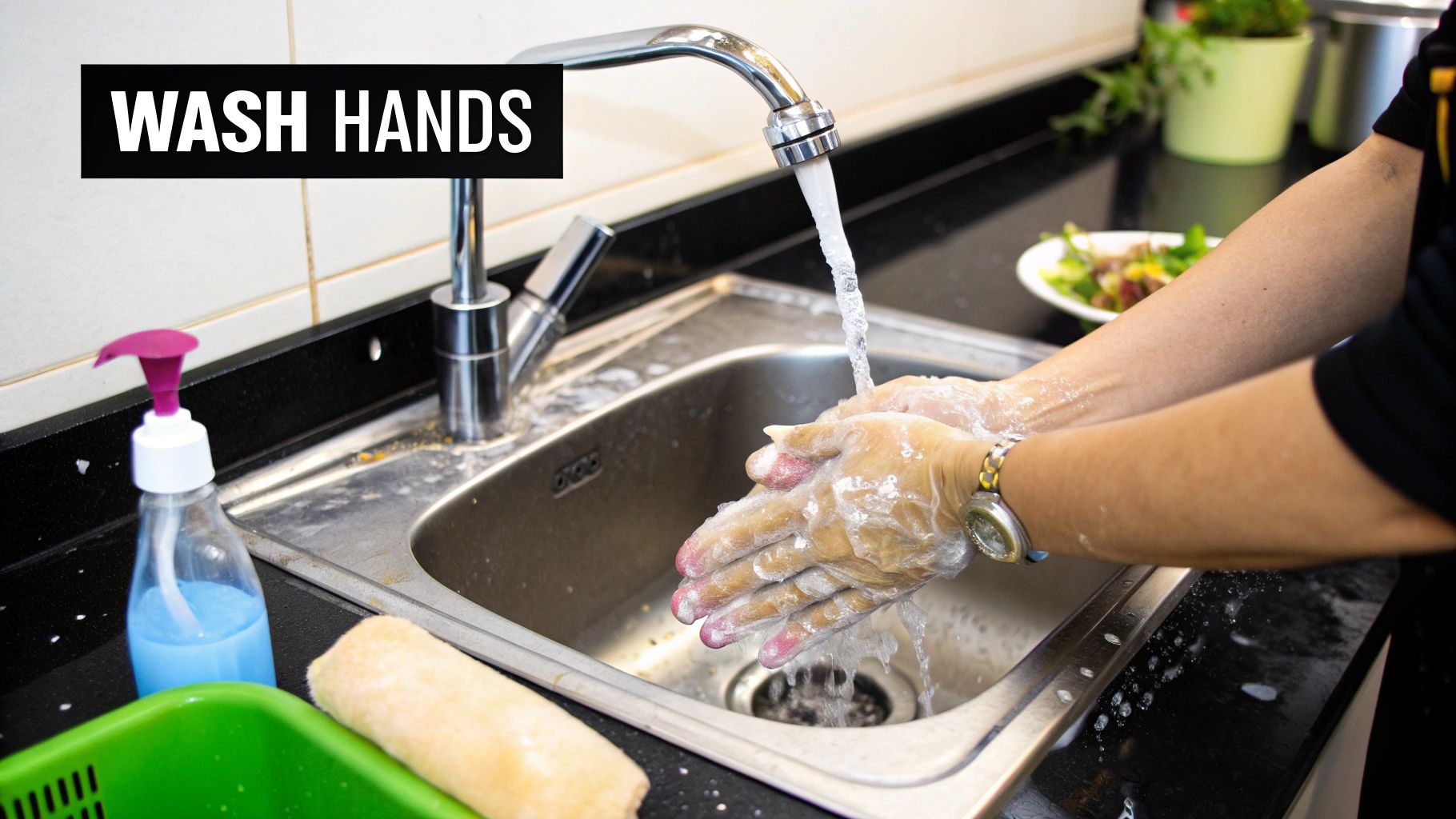
Food contamination is more than a spoiled meal or a stomach ache. It’s a serious public health threat with real consequences for our communities, economies, and especially the most vulnerable among us.
When harmful bacteria, viruses, or parasites get into our food, the results can be devastating. It's not just discomfort. Severe foodborne illnesses can lead to hospitalization, long-term health issues, and even death. This reality turns everyday meals—a family dinner, a catered event, or a night out—into potential risks if we let our guard down.
The Staggering Global Impact
The scale of this problem is massive. Unsafe food causes an estimated 600 million cases of foodborne diseases worldwide every year, leading to about 420,000 deaths. The most heartbreaking part? A full 30% of those deaths are children under five.
Beyond the human cost, the economic toll is huge, with low- and middle-income countries losing around $110 billion annually in medical expenses and lost productivity. These numbers are a call to action. They show why knowing how to prevent food contamination is a non-negotiable skill for global health.
This is why strict food handling practices are vital everywhere, from a Michelin-starred kitchen to your own. If you work in the food industry, mastering these skills is part of the job. Our detailed guide to restaurant food safety offers an even deeper dive.
At its core, food safety is a shared responsibility. Every person who handles food, from the professional chef to the home cook, plays a vital role in the chain of prevention.
More Than Just Germs
When we talk about contamination, we usually think of bacteria and viruses. But the threats are broader. Harmful agents fall into several categories, and each requires a different prevention strategy.
- Physical Contaminants: Any foreign object that shouldn't be in your food—glass slivers, metal shavings, plastic bits, hair, or stray bones.
- Chemical Contaminants: This includes cleaning agents, pesticides, or unapproved additives that can be toxic if consumed.
- Allergenic Contaminants: This happens when an allergen, like peanut dust or shellfish residue, transfers to a food that should be free of it. For someone with a severe allergy, this can be life-threatening.
Understanding this full spectrum of risk is key. It proves that preventing food contamination requires a comprehensive approach that covers everything from scrubbing surfaces to sourcing ingredients. The next sections provide the practical advice you need to tackle these challenges head-on.
Mastering the Four Core Food Safety Principles
To prevent food contamination, you don't need a culinary degree. The secret is sticking to four foundational principles that are the bedrock of food safety everywhere: Clean, Separate, Cook, and Chill.
These aren't just buzzwords; they're your most powerful tools against foodborne illness. Integrating these practices into your cooking routine creates a built-in defense system that protects you and everyone you feed. Let's break down what each one means in action.
Clean: Your First Line of Defense
It sounds simple, but starting with a clean environment is non-negotiable. Pathogens are invisible hitchhikers that travel from hands, surfaces, and utensils directly to your food. A meticulous approach to cleaning is always step one.
It starts with your hands. The CDC estimates that proper handwashing could prevent about 1 in 3 diarrheal illnesses and 1 in 5 respiratory infections. Before touching any ingredients—and especially after handling raw meat, poultry, or eggs—wash your hands with soap and warm water for at least 20 seconds. Make it an automatic habit.
Your entire kitchen is a potential transfer zone for germs, so don't stop at your hands.
- Surfaces & Tools: Sanitize countertops, cutting boards, and knives after each use. A simple, effective solution is one tablespoon of unscented liquid chlorine bleach in a gallon of water.
- Reusable Grocery Bags: These are often-overlooked hotspots for bacteria. Toss fabric bags in the wash regularly and wipe down plastic-lined ones with a sanitizing cloth.
- Fresh Produce: Rinse fresh fruits and vegetables under running water before eating or cutting them. Even if you plan to peel a melon or cucumber, the knife can drag bacteria from the peel directly into the flesh.
Separate: Avoid Cross-Contamination
Cross-contamination is one of the most common ways food becomes unsafe. It happens when germs from a raw food, like chicken, transfer to something that won't be cooked, like salad greens. The "Separate" rule is all about creating physical barriers to stop this transfer.
Your cutting board is a prime example. If you chop raw chicken and then use the same board to slice a tomato, you’re creating a recipe for illness. The fix is simple: use different cutting boards for different foods. Many pros use a color-coded system—one for raw meats, another for produce—to make it foolproof.
The same logic applies to your refrigerator.
Store raw meat, poultry, and seafood on the bottom shelf in sealed containers or leak-proof bags. This simple habit prevents their juices, which can be full of bacteria like Salmonella or E. coli, from dripping down and contaminating other foods.
The mindset is simple: treat all raw animal products as if they are contaminated. By containing them and their juices, you dramatically cut the risk of spreading harmful pathogens.
Cook: Temperature Is Everything
Cooking does more than make food taste good; it’s a critical safety step that kills harmful bacteria. But you can't judge doneness by color or time alone. The only way to be sure food has reached a safe temperature is to use a food thermometer.
A reliable digital food thermometer is one of the best investments for your kitchen. Different foods have different safety targets. For instance, all poultry must hit an internal temperature of 165°F (74°C) to be safe, while a medium-rare steak is safe at 145°F (63°C).
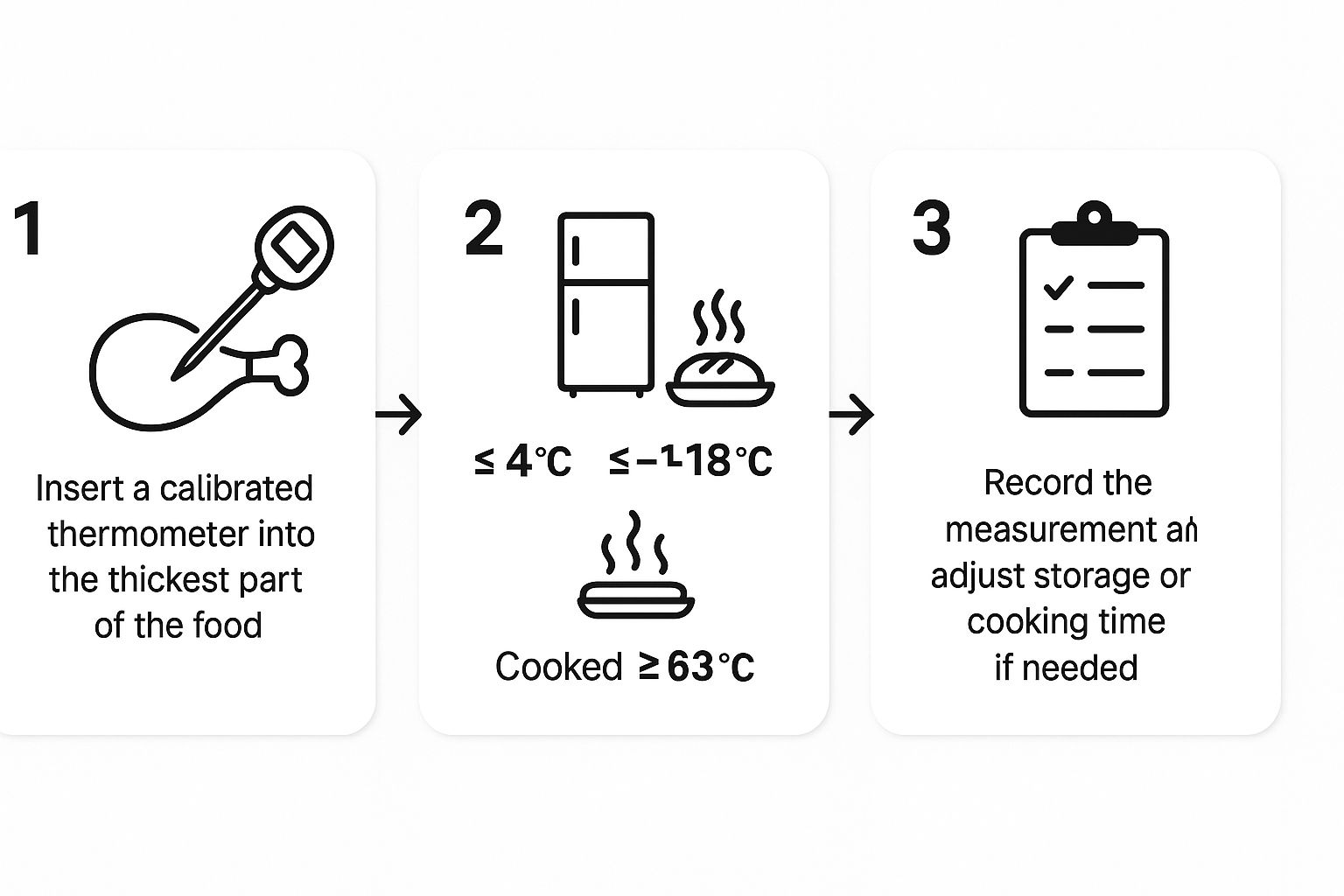
Guesswork has no place in a safe kitchen. Measuring the internal temperature is the final checkpoint before you serve a meal.
Here's a quick-reference guide for common foods. Keep these numbers in mind every time you cook.
Safe Internal Cooking Temperatures
| Food Type | Minimum Internal Temperature (°F) | Minimum Internal Temperature (°C) |
|---|---|---|
| Poultry (Chicken, Turkey) | 165°F | 74°C |
| Ground Meats (Beef, Pork) | 160°F | 71°C |
| Beef, Pork, Lamb (Steaks, Roasts) | 145°F (with 3-min rest) | 63°C (with 3-min rest) |
| Fish & Shellfish | 145°F | 63°C |
| Eggs & Egg Dishes | 160°F | 71°C |
| Leftovers & Casseroles | 165°F | 74°C |
Using this table with a food thermometer removes all doubt, ensuring every meal is not just delicious, but safe.
Chill: Mind the "Danger Zone"
The final pillar, Chill, is about what you do after the food is cooked. Bacteria multiply incredibly fast in the "danger zone"—the temperature range between 40°F (4°C) and 140°F (60°C). Your job is to get food out of this zone as quickly as possible.
Follow the "two-hour rule." Any perishable food, from leftovers to party platters, must be in the fridge within two hours of being cooked. On a hot day—over 90°F (32°C)—that window shrinks to just one hour.
Cooling a large pot of soup or chili presents a challenge. Sticking a hot pot straight into the fridge can raise the appliance's temperature, putting all other food at risk. Instead, cool it down quickly.
Two pro tricks work wonders:
- Divide the food into smaller, shallow containers to increase surface area and let heat escape faster.
- For a rapid cooldown, place the container in an ice-water bath and stir.
Finally, check your appliances. Your refrigerator should be at or below 40°F (4°C), and your freezer at 0°F (–18°C). An inexpensive appliance thermometer can confirm your settings are accurate, ensuring your food is always stored safely.
Smart Shopping and Storage: Your First Line of Defense
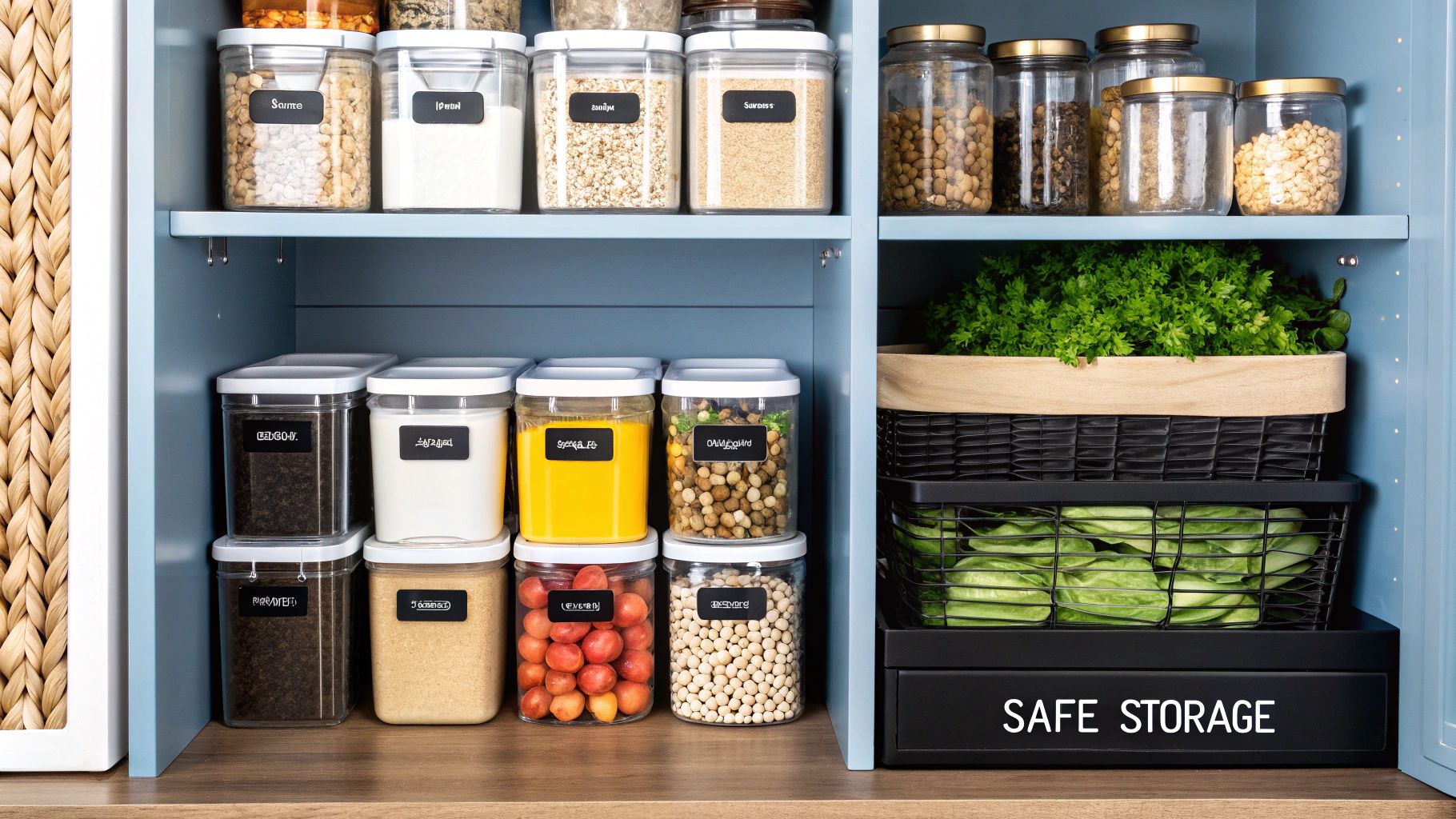
Food safety starts the moment you walk into the grocery store, not at your stovetop. Every choice you make, from the items you select to how you pack your cart, is a crucial step in preventing contamination. Get this foundation right, and everything that follows in the kitchen becomes much safer.
Your grocery run is your first chance to screen for hazards. A little vigilance goes a long way. Before putting anything in your cart, inspect the packaging. Avoid cans that are dented, bulging, or rusted, as these can be signs of botulism. Also, skip any packages that are torn, leaking, or have broken seals.
Treating your shopping trip like a quality control mission ensures you start with safe, high-quality ingredients.
Navigate the Aisles Like a Pro
How you organize your shopping cart matters. Cross-contamination can happen long before you get to your kitchen. To keep food safe, mentally divide your cart into zones.
Start with non-perishable items like canned goods and pasta. Then, move on to fresh produce. The very last items in your cart should always be raw meat, poultry, and seafood. This sequence minimizes the time these high-risk foods spend at warmer temperatures.
- Bag Separately: Always place raw meats in their own plastic bags to prevent juices from dripping onto other foods. Most stores provide these bags in the meat department—use them.
- Keep It Cold: If you have a long drive home, bring an insulated cooler bag for cold items, especially raw meat and dairy.
This strategic approach is one of the easiest ways to stop raw juices from contacting ready-to-eat foods like fruits and vegetables—a common source of foodborne illness.
Understanding food labels is another key skill. "Best-by" and "use-by" dates are mostly about quality and freshness, not always safety. However, you should always follow "use-by" dates on perishables like dairy and meat to minimize risk.
An Organized Fridge is a Safer Fridge
Once you get groceries home, the clock is ticking. You have about two hours to get all perishable items into the fridge or freezer. But don't just toss them in anywhere. How you organize your fridge is vital for preventing cross-contamination.
The golden rule of fridge storage is simple: store raw meat, poultry, and seafood on the bottom shelf. This is the single most effective way to prevent their juices from dripping onto and contaminating other foods. For extra protection, place them in a sealed container or on a lipped tray.
Here’s a quick guide for organizing your fridge from top to bottom for maximum safety:
- Top Shelf & Door: For ready-to-eat foods like leftovers, drinks, and condiments.
- Middle Shelves: A good spot for dairy, eggs, and other prepared foods.
- Bottom Shelf: The designated zone for raw meat, poultry, and seafood, always in sealed containers.
- Crisper Drawers: Use for fruits and vegetables. Keep them separate, as some fruits release ethylene gas that can make certain vegetables spoil faster.
This top-to-bottom strategy creates a logical flow that keeps potential contaminants contained at the lowest point, safeguarding everything else.
Finally, don't forget the pantry. Store dry goods in a cool, dark, and dry place. Transfer items like flour, sugar, and grains into airtight containers to extend their shelf life and keep them fresh. A well-organized kitchen, from cart to counter, is your strongest line of defense.
Pinpointing High-Risk Foods and Kitchen Hotspots
Not all foods carry the same contamination risk, and certain spots in your kitchen are natural magnets for bacteria. Knowing where the real dangers lie helps you focus your cleaning and handling efforts where they matter most.
It’s all about working smarter. A little extra diligence in these key areas can make a massive difference in keeping your food safe.
Tackling Common Kitchen Hotspots
Your kitchen can look spotless, but germs love to hide in plain sight. These "hotspots" can quickly become contamination zones, spreading bacteria to your hands, tools, and food.
Believe it or not, the kitchen sponge is often the single dirtiest item in a home. Studies show it can harbor more bacteria than a toilet seat, thanks to its damp, porous nature—a perfect breeding ground for microbes.
- Sponges and Dishcloths: Sanitize them daily. Run them through a full dishwasher cycle or microwave a damp sponge for one minute to kill off germs.
- The Sink Drain: This area is a constant collection of food bits and moisture. Once a week, pour a diluted bleach solution down the drain and regularly scrub the sink basin and faucet handles.
- Cutting Boards: Deep grooves and scratches in old cutting boards are perfect hiding places for bacteria. Use separate boards for raw meat and produce. Once a board is heavily scored and worn, replace it.
Even small pests can signal bigger problems. Seeing fruit flies means there's likely some overripe produce or a sticky spill you missed. For more tips, check our guide on how to control fruit flies.
A truly clean kitchen goes beyond what you can see. Preventing food contamination happens at a microscopic level, which is why sanitizing these key hotspots is an essential part of any food safety routine.
A Closer Look at High-Risk Foods
While any food can become contaminated, some are naturally more likely to carry harmful pathogens. These are the foods that demand extra care, from the grocery store to your plate. Don't fear them, just handle them with heightened awareness.
Raw sprouts are a classic example and a known source of foodborne illness outbreaks. The warm, humid environment needed for them to grow is also the perfect setting for bacteria like E. coli and Salmonella to thrive. That’s why it’s widely recommended that young children, the elderly, pregnant women, and anyone with a compromised immune system should avoid raw sprouts.
Here are a few other foods that require your full attention:
- Leafy Greens: Their nooks and crannies can trap contaminants. Wash them thoroughly under cool running water, even if the bag says "pre-washed."
- Raw Poultry and Meat: These are well-known carriers of Salmonella and Campylobacter. Keeping them completely separate from other foods during shopping, storage, and prep is non-negotiable.
- Undercooked Eggs: A runny yolk can be delicious, but raw or lightly cooked eggs pose a Salmonella risk. Use pasteurized eggs for recipes calling for raw eggs, like Caesar dressing or homemade mayo.
- Shellfish: Oysters and clams are filter feeders, meaning they can accumulate bacteria from the water. Always buy shellfish from a trusted source and cook them until their shells pop open.
These risks are real. Global food recall data from a single recent month showed around 3,500 incidents. Of these, 2,239 were control incidents and 794 were full-blown recalls. The most affected categories were fruits, vegetables, and meat products, reinforcing just how important these targeted safety measures are.
By understanding the specific risks tied to these foods and kitchen hotspots, you can adopt strategies that truly work to prevent contamination.
The Science Behind Safer Food Practices
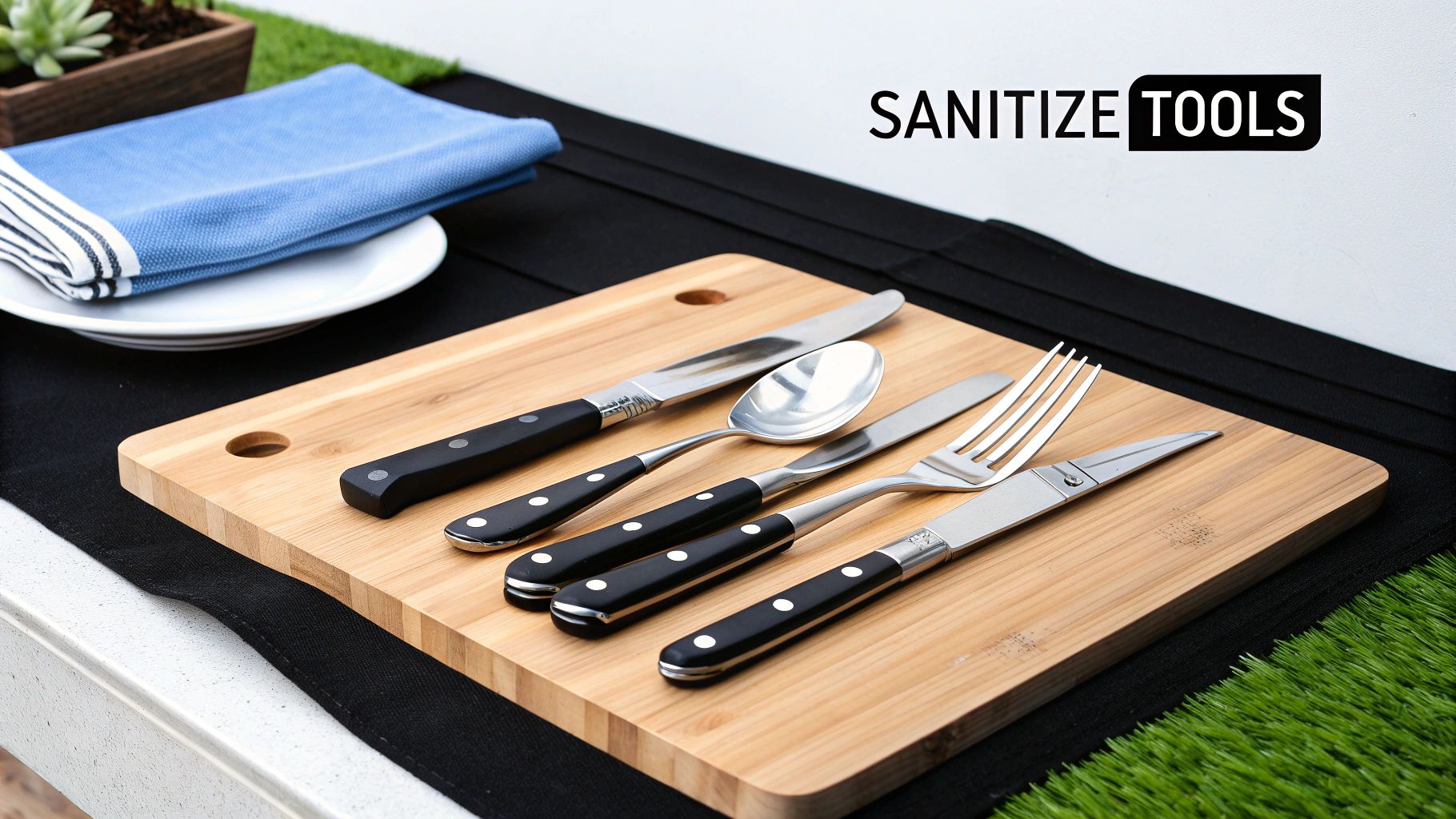
Following food safety rules is one thing; understanding why they exist is another. When you grasp the science, you can make smart, safe decisions in any situation. These aren't arbitrary regulations; they’re built on decades of microbiology and risk assessment designed to keep people healthy.
At its core, preventing food contamination is about controlling the growth and spread of microorganisms. We can't see pathogens like bacteria and viruses, but we know they need food, moisture, and the right temperature to multiply. This simple fact is the basis for all foundational food safety practices.
Temperature: Your Most Critical Tool
You’ve heard of the "danger zone"—the temperature range between 40°F (4°C) and 140°F (60°C). This isn't just a catchy phrase. It’s the optimal environment where dangerous bacteria like Salmonella and E. coli can double in number in as little as 20 minutes.
Chilling food below 40°F doesn't kill bacteria, but it slows their growth to a crawl—like hitting a pause button. Conversely, cooking food to its proper internal temperature is the kill step. The heat destroys the pathogens' cellular structure, making them harmless. That’s why a good food thermometer is one of the most scientific tools in your kitchen—it gives you the data to confirm you've eliminated the risk.
Understanding the science of temperature control shifts your mindset from "following rules" to actively managing risk. You're no longer just cooking chicken; you're executing a scientifically validated process to ensure its safety.
Cross-contamination is simply the physical transfer of microbes from a dirty surface to a clean one. When raw chicken juice touches fresh lettuce, you create a direct pathway for bacteria. Using separate cutting boards and utensils creates a physical barrier that stops this migration.
This thinking also extends to pest control. Pests are notorious for carrying pathogens. A comprehensive, science-based approach means looking at every angle, including whether preventative tools like fly fans actually work to create a more sanitary environment.
A Global Framework Backed by Science
These principles aren't just kitchen wisdom; they’re the foundation of international food safety standards. The core strategy to prevent food contamination comes from science-based practices developed by global bodies like the Codex Alimentarius Commission.
The WHO's famous Five Keys to Safer Food—keep clean, separate raw and cooked, cook thoroughly, keep food at safe temperatures, and use safe water and raw materials—are all evidence-backed guidelines. They translate complex science into simple, actionable steps anyone can follow. Modern technology has only made us better, with tools like whole genome sequencing allowing health officials to track foodborne pathogens faster than ever. It's all part of a proactive, global strategy to keep our food supply safe.
Your Top Food Safety Questions, Answered
Even with the best intentions, tricky food safety situations come up. Let's tackle some of the most common questions so you can feel confident you're making the safest choice every time.
Is It Really Okay to Refreeze Thawed Food?
It depends entirely on how you thawed it.
If you defrosted raw meat, poultry, or seafood in the refrigerator, you're in the clear. You can safely refreeze it, though the texture might change slightly.
However, if you used a quicker method like the microwave or a cold-water bath, the rules change. Those methods can warm the food enough to enter the "danger zone" where bacteria multiply rapidly. In this case, you must cook it immediately before considering refreezing. Cooking will kill off any bacteria that started to grow.
The golden rule: never refreeze food that has been left at room temperature for more than two hours (or one hour if it's over 90°F). It's not worth the risk.
So, Is the Five-Second Rule a Real Thing?
The five-second rule is a myth. From a food safety standpoint, it's wishful thinking.
Scientific studies have shown that bacteria transfer from a surface to your food almost instantly. While the type of food and surface moisture affect how many bacteria transfer, a significant number makes the jump in a split second.
If the floor has harmful bacteria like E. coli or Salmonella, it's on your dropped food immediately. To prevent food contamination, the only smart move is to toss anything that hits the floor.
How Should I Be Cleaning My Reusable Shopping Bags?
Eco-friendly bags are great, but they can easily become a playground for germs. A small leak from a raw chicken package can contaminate the bag, which can then cross-contaminate your fresh produce on the next trip.
Here's a simple system to keep them safe:
- Assign Jobs: Dedicate specific bags for raw meats. Keep them separate from the bags used for produce and ready-to-eat foods.
- Wash Them Often: Machine wash fabric bags in hot water after every few trips, and always after carrying raw meat.
- Wipe Down Liners: For insulated or plastic-lined bags, wipe them down with a sanitizing wipe or hot, soapy water after every use.
What’s the Right Way to Reheat Leftovers?
When you reheat leftovers, the goal isn't just to make them warm. You need to bring them to a temperature that kills any bacteria that may have grown in the fridge.
The magic number is 165°F (74°C). No matter how you're reheating—microwave, oven, or stovetop—the food must hit this internal temperature to be safe.
Bring soups and sauces to a full, rolling boil on the stove. If using a microwave, stir the food halfway through to eliminate cold spots where bacteria can survive. The only way to be 100% sure is to use a food thermometer. It takes all the guesswork out of the equation.
Ready to create a safer, more comfortable dining experience free from pests? MODERN LYFE offers stylish and effective fly fans that protect your food with quiet, modern design. Explore our collection and enjoy pest-free meals.

